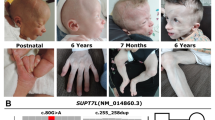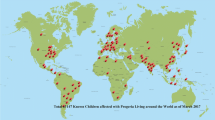Abstract
X-linked hypophosphatemic rickets (XLH) in humans is caused by mutations in the PHEX gene. Previously, three mutations in the mouse Phex gene have been reported: Phex Hyp, Gy, and Phex Ska1. Here we report analysis of two new spontaneous mutations in the mouse Phex gene, Phex Hyp-2J and Phex Hyp-Duk. Phex Hyp-2J and Phex Hyp-Duk involve intragenic deletions of at least 7.3 kb containing exon 15, and 30 kb containing exons 13 and 14, respectively. Both mutations cause similar phenotypes in males, including shortened hind legs and tail, a shortened square trunk, hypophosphatemia, hypocalcemia, and rachitic bone disease. In addition, mice carrying the Phex Hyp-Duk mutation exhibit background-dependent variable expression of deafness, circling behavior, and cranial dysmorphology, demonstrating the influence of modifying genes on Phex-related phenotypes. Cochlear cross-sections from Phex Hyp-2J/Y and Phex Hyp-Duk/Y males reveal a thickening of the temporal bone surrounding the cochlea with the presence of a precipitate in the scala tympani. Evidence of the degeneration of the organ of Corti and spiral ganglion also are present in the hearing-impaired Phex Hyp-Duk/Y mice, but not in the normal-hearing Phex Hyp-2J/Y mice. Analysis of the phenotypes noted in Phex Hyp-Duk/Y an Phex Hyp-2J/Y males, together with those noted in Phex Ska1/Y and Phex Hyp/Y males, now allow XLH-related phenotypes to be separated from non-XLH-related phenotypes, such as those noted in Gy/Y males. Also, identification of the genetic modifiers of hearing and craniofacial dysmorphology in Phex Hyp-Duk/Y mice could provide insight into the phenotypic variation of XLH in humans.
Similar content being viewed by others
References
C Barkway N Glenn D Harvey P Moorjani A Palmer et al. (1988) ArticleTitleHearing impairment associated with hypophosphatemia: the Gyro mutant mouse. Hered Deafness Newslett 1 20–21
C Barkway N Glenn P Moorjani A Palmer S Stabler et al. (1989) ArticleTitleHearing impairment in two mouse mutants with hypophosphatemia. Hered Deafness Newslett 3 20–21
A Boneh TM Reade CR Scriver E Rishikof (1987) ArticleTitleAudiometric evidence for two forms of X-linked hypophosphatemia in humans, apparent counterparts of Hyp and Gy mutations in mouse. Am J Med Genet 27 997–1003 Occurrence Handle1:STN:280:BieC3czntVQ%3D Occurrence Handle3425609
CH Burnett CE Dent C Harper BJ Warland (1964) ArticleTitleVitamin-D resistant rickets. Am J Med 36 222–232 Occurrence Handle1:STN:280:CCuD1c3ktl0%3D Occurrence Handle14124689
MR Carpinelli IP Wicks NA Sims K O’Donnell K Hanzinikolas et al. (2002) ArticleTitleAn ethyl-nitrosourea-induced point mutation in Phex causes exon skipping, X-linked hypophosphatemia, and rickets. Am J Pathol 161 1925–1933 Occurrence Handle1:CAS:528:DC%2BD38XptV2gur8%3D Occurrence Handle12414538
M Davies R Kane J Valentine (1984) ArticleTitleImpaired hearing in X-linked hypophosphataemic (vitamin-D-resistant) osteomalacia. Ann Intern Med 100 230–232 Occurrence Handle1:STN:280:BiuC3c3nsVA%3D Occurrence Handle6691666
MT Davisson (1990) ArticleTitleThe Jackson Laboratory mouse mutant resource. Lab Anim 19 23–29
EM Eicher JL Southard CR Scriver FH Glorieux (1976) ArticleTitleHypophosphatemia: mouse model for human familial hypophosphatemic (vitamin D-resistant) rickets. Proc Natl Acad Sci USA 73 4667–4671 Occurrence Handle1:CAS:528:DyaE2sXntVCrtg%3D%3D Occurrence Handle188049
CD Gonzalez RA Meyer Jr RJ Iorio (1992) ArticleTitleCraniometric measurements of craniofacial malformations in the X-linked hypophosphatemic (Hyp) mouse on two different genetic backgrounds: C57BL/6J and B6C3H. Teratology 46 605–613 Occurrence Handle1:STN:280:ByyC2svktV0%3D Occurrence Handle1290161
IA Holm AE Nelson BG Robinson RS Mason DJ Marsh et al. (2001) ArticleTitleMutational analysis and genotype-phenotype correlation of the PHEX gene in X-linked hypophosphatemic rickets. J Clin Endocrinol Metab 86 3889–3899 Occurrence Handle10.1210/jc.86.8.3889 Occurrence Handle1:CAS:528:DC%2BD3MXlvFersr4%3D Occurrence Handle11502829
KR Johnson QY Zheng LC Erway (2000) ArticleTitleA major gene affecting age-related hearing loss is common to at least ten inbred strains of mice. Genomics 70 171–180
B Lorenz F Francis K Gempel A Boddrich M Josten et al. (1998) ArticleTitleSpermine deficiency in Gy mice caused by deletion of the spermine synthase gene. Hum Mol Genet 7 541–547 Occurrence Handle10.1093/hmg/7.3.541 Occurrence Handle1:CAS:528:DyaK1cXitFWku7Y%3D Occurrence Handle9467015
MF Lyon CR Scriver LR Baker HS Tenenhouse J Kronick et al. (1986) ArticleTitleThe Gy mutation: another cause of X-linked hypophosphatemia in mouse. Proc NatI Acad Sci USA 83 4899–4903 Occurrence Handle1:CAS:528:DyaL28XksF2jsro%3D
SC Marks RL Lindahl JW Bawden (1965) ArticleTitleDental and cephalometric findings in vitamin D resistant rickets. J Dent Child 32 259–265 Occurrence Handle1:STN:280:CCmD3cvlslI%3D Occurrence Handle5318264
RA Meyer Jr MH Meyer RW Gray ME Bruns (1995) ArticleTitleFemoral abnormalities and vitamin D metabolism in X-linked hypophosphatemic (Hyp and Gy) mice. J Orthop Res 13 30–40 Occurrence Handle1:STN:280:ByqC2MnhslA%3D Occurrence Handle7853101
S O’Malley RT Ramsden A Latif R Kane M Davies (1985) ArticleTitleElectrocochleographic changes in the hearing loss associated with X-linked hypophosphataemic osteomalacia. Acta Otolaryngol 100 13–18 Occurrence Handle1:STN:280:BiqB2srjsFQ%3D Occurrence Handle4040696
SP O’Malley JE Adams M Davies RT Ramsden (1988) ArticleTitleThe petrous temporal bone and deafness in X-linked hypophosphataemic osteomalacia. Clin Radiol 39 528–530 Occurrence Handle1:STN:280:BiaD38blt1w%3D Occurrence Handle3180671
B Reilly J Leeming M Fraser (1964) ArticleTitleCraniosynostosis in the rachitic spectrum. J Pediatr 64 396–401 Occurrence Handle1:STN:280:CCuD1cfkvVQ%3D Occurrence Handle14130713
JT Richtsmeier LL Baxter RH Reeves (2000) ArticleTitleParallels of craniofacial maldevelopment in Down syndrome and Ts65Dn mice. Dev Dyn 217 137–145 Occurrence Handle10.1002/(SICI)1097-0177(200002)217:2<137::AID-DVDY1>3.0.CO;2-N Occurrence Handle1:STN:280:DC%2BD3c7mvVKmtw%3D%3D Occurrence Handle10706138
Y Sabbagh C Gauthier HS Tenenhouse (2002) ArticleTitleThe X chromosome deletion in HYP mice extends into the intergenic region but does not include the SAT gene downstream from Phex. Cytogenet Genome Res 99 344–349 Occurrence Handle10.1159/000071613 Occurrence Handle1:CAS:528:DC%2BD3sXmtVKksr8%3D Occurrence Handle12900584
J Sela I Bab MS Deol (1982) ArticleTitlePatterns of matrix vesicle calcification in osteomalacia of Gyro mice. Metab Bone Dis Relat Res 4 129–134 Occurrence Handle1:STN:280:BiyD283gt1Y%3D Occurrence Handle7144561
NS Shetty J Meyer (1991) ArticleTitleCraniofacial abnormalities in mice with X-linked hypophosphatemic genes (Hyp or Gy). Teratology 44 463–472 Occurrence Handle1:STN:280:By2D2svgtlE%3D Occurrence Handle1962291
TM Strom F Francis B Lorenz A Boddrich MJ Econs et al. (1997) ArticleTitlePex gene deletions in Gy and Hyp mice provide mouse models for X-linked hypophosphatemia. Hum Mol Genet 6 165–171 Occurrence Handle1:CAS:528:DyaK2sXht1ajs7g%3D Occurrence Handle9063736
HS Tenenhouse (1999) ArticleTitleX-linked hypophosphataemia: a homologous disorder in humans and mice. Nephrol Dial Transplant 14 333–341 Occurrence Handle1:CAS:528:DyaK1MXhslGnu7Y%3D Occurrence Handle10069185
InstitutionalAuthorNameThe HYP Consortium (1995) ArticleTitleA gene (PEX) with homologies to endopeptidases is mutated in patients with X-linked hypophosphatemic rickets. Nat Genet 11 130–136 Occurrence Handle7550339
WE Tracy RA Campbell (1968) ArticleTitleDentofacial development in children with vitamin D resistant rickets. J Am Dent Assoc 76 1026–1031 Occurrence Handle1:STN:280:CCeA287htFU%3D Occurrence Handle5243735
PF Ward-Bailey B Wood KR Johnson RT Bronson LR Donahue et al. (2000) ArticleTitleNeuromuscular ataxia: a new spontaneous mutation in the mouse. Mamm Genome 11 820–823 Occurrence Handle10.1007/s003350010167 Occurrence Handle1:CAS:528:DC%2BD3cXnsleitLg%3D Occurrence Handle11003693
N Weir (1977) ArticleTitleSensorineural deafness associated with recessive hypophosphataemic rickets. J Laryngol Otol 91 717–722 Occurrence Handle1:STN:280:CSiB2M7hs1c%3D Occurrence Handle894124
QY Zheng KR Johnson LC Erway (1999) ArticleTitleAssessment of hearing in 80 inbred strains of mice by ABR threshold analyses. Hear Res 130 94–107 Occurrence Handle10.1016/S0378-5955(99)00003-9 Occurrence Handle1:STN:280:DyaK1M3ltFyiuw%3D%3D Occurrence Handle10320101
Acknowledgements
We thank Wesley G. Beamer and Tali Shalom-Barak for their careful review of this manuscript, as well as H. Hellebrand, Heping Yu, and Sandra Gray for their technical assistance and contribution to this study. We are indebted to Susan Poulton for originally discovering the Hyp-Duk mutation at The Urology Research Department at Duke University. We also thank Roderick Bronson for pathohistological evaluation and Coleen Marden for colony maintenance. This work was supported by grants from the Deutsche Forschungsgemeinschaft (STR304/2-1), by the National Institutes of Health grants RR01183, CF-DE13078-03, contract DC62108 and by the Cancer Core grant CA34196 from the National Cancer Institute.
Author information
Authors and Affiliations
Corresponding author
Rights and permissions
About this article
Cite this article
Lorenz-Depiereux, B., Guido, V.E., Johnson, K.R. et al. New intragenic deletions in the Phex gene clarify X-linked hypophosphatemia-related abnormalities in mice . Mamm Genome 15, 151–161 (2004). https://doi.org/10.1007/s00335-003-2310-z
Received:
Accepted:
Issue Date:
DOI: https://doi.org/10.1007/s00335-003-2310-z




